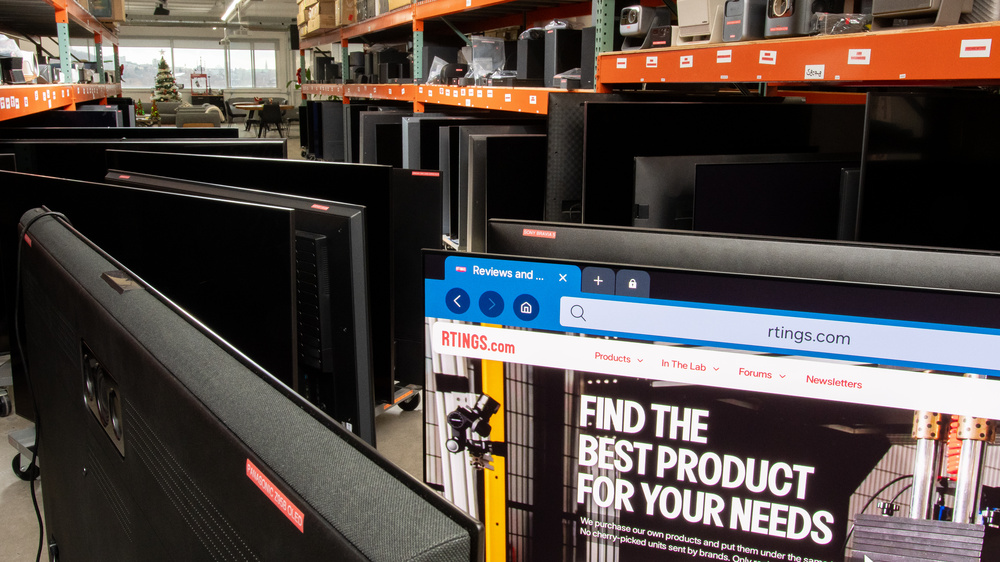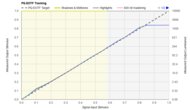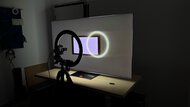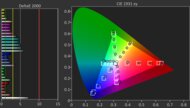If you find yourself searching for a new TV and become overwhelmed by the number of options, you can easily narrow your search by looking for the best option based on your price range. Whether it's a high-end model or a cheaper TV, we perform over 350 rigorous tests that inform what models we recommend for most people. Our testing helps us determine how a TV performs in a bright room, how good it looks in a dark room, the vibrancy of colors, and how each TV handles motion, just to name a few.
High-end TVs deliver the best picture quality, but they're also expensive, so if you want something cheaper, you'll usually have to sacrifice some features. Choosing the best TV on the market also depends on the content you watch and where you're going to place it; if you watch a lot of 4k HDR content, you might want a top-quality TV, but if you're just watching the news on a cable box in a dim room, you can go for something cheaper.
To learn more about the models in stores now, check out our 2025 TV lineup page. You can also vote on which new models you want us to buy and test. Below are our picks for the best TVs on the market that you can currently purchase. Also, take a look at our picks for the best TV brands, the best gaming TVs, and the best budget TVs.
Quick Look

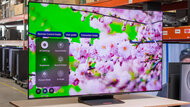




We buy and test dozens of TVs yearly, taking an objective, data-driven approach to deliver results you can trust. Our testing process is complex, with hundreds of individual tests that take over a week to complete. Most of our tests are done with specially designed test patterns that mimic real content, but we also use the same sources you have at home to ensure our results match the real-world experience. We use two main tools for our testing: a Colorimetry Research CR-100 colorimeter and a CR-250 spectroradiometer.
-
Best TV
 Mixed Usage8.9Home Theater9.0Bright Room8.8Sports8.8Gaming9.3Brightness8.7Black Level10Color9.1Processing (In Development)8.3Game Mode Responsiveness9.4Resolution4kNative Refresh Rate165HzScreen FinishMatteTypeOLEDSub-TypeQD-OLEDSee all our test resultsDolby VisionNo
Mixed Usage8.9Home Theater9.0Bright Room8.8Sports8.8Gaming9.3Brightness8.7Black Level10Color9.1Processing (In Development)8.3Game Mode Responsiveness9.4Resolution4kNative Refresh Rate165HzScreen FinishMatteTypeOLEDSub-TypeQD-OLEDSee all our test resultsDolby VisionNoIf you're looking for a TV that does it all, the Samsung S95F OLED is the best TV currently available. It offers a complete package of top-tier image quality, gaming features, and versatility. This QD-OLED model displays unrivaled colors that are rich, accurate, bright, and incredibly vivid. This TV displays inky blacks alongside bright highlights, so HDR content looks incredible in dark rooms, such as home theaters. Many OLEDs struggle with reflections in bright rooms, but this model's combination of a matte screen coating and excellent SDR brightness means reflections are a non-issue, even in the brightest spaces. If you have a large room with seating off to the sides, this TV is a perfect fit, as its image quality remains consistent even when viewed from an angle. It even comes with Samsung's external Slim One Connect Box, which offers you a versatile way to plug in your devices and keep your setup clean.
The TV's superb image quality makes games look amazing, and it's also equipped with a ton of modern gaming features. It has four HDMI 2.1 ports that are capable of 4k @ 165Hz, so not only does it take full advantage of the refresh rates offered by modern consoles, but it also pairs excellently with powerful gaming PCs. You also get all three flavors of VRR, so you get a nearly tear-free gaming experience no matter what console or PC you game on. Additionally, the TV features nearly instantaneous pixel transitions, a hallmark of OLED technology, ensuring that fast motion is crystal clear. Some home theater enthusiasts might be put off by the TV's lack of Dolby Vision support. However, on a TV this bright, the benefits of Dolby Vision aren't as noticeable, and you still get the very similar HDR10+.
-
Best Upper Mid-Range TV
 Mixed Usage8.6Home Theater8.8Bright Room7.6Sports8.1Gaming9.1Brightness8.0Black Level10Color8.8Processing (In Development)8.4Game Mode Responsiveness9.4Resolution4kNative Refresh Rate144HzScreen FinishGlossyTypeOLEDSub-TypeQD-OLEDSee all our test resultsDolby VisionNo
Mixed Usage8.6Home Theater8.8Bright Room7.6Sports8.1Gaming9.1Brightness8.0Black Level10Color8.8Processing (In Development)8.4Game Mode Responsiveness9.4Resolution4kNative Refresh Rate144HzScreen FinishGlossyTypeOLEDSub-TypeQD-OLEDSee all our test resultsDolby VisionNoIf you want a QD-OLED TV like the Samsung S95F OLED, but it's too expensive, you can get very similar image quality by going with the Samsung S90F OLED. It features a more traditional glossy screen coating and doesn't appear as bright in SDR, which results in less effective handling of reflections. It still handles reflection well, and it's definitely not a dim TV in SDR, so you can still use it in a moderately lit room without worrying about distracting reflections on the screen. Fortunately, the TV is still bright in HDR, so highlights really pop out in HDR content. Combine that with its vivid colors and perfect black levels, and you get a TV with top-tier image quality in a dark room, making it a great choice for home theaters. You also still get the same incredibly wide viewing angle, making it a great choice for large living rooms.
It doesn't come with Samsung's Slim One Connect Box, but it still has four HDMI 2.1 ports capable of 4k @ 144Hz with VRR. Furthermore, you get the same nearly instantaneous pixel transitions, so fast motion is sharp and clear. Like the S95F and all Samsung TVs, this model doesn't support Dolby Vision, but you still get HDR10+. Unfortunately, only the 55, 65, and 77-inch sizes use a QD-OLED panel, whereas the other sizes use a WOLED panel. Even then, this varies depending on where you live.
-
Best Mid-Range TV
 Mixed Usage8.4Home Theater8.6Bright Room8.4Sports8.3Gaming8.4Brightness9.1Black Level9.2Color8.0Processing (In Development)7.8Game Mode Responsiveness8.0Resolution4kNative Refresh Rate144HzScreen FinishGlossyTypeLEDSub-TypeVASee all our test resultsDolby VisionYes
Mixed Usage8.4Home Theater8.6Bright Room8.4Sports8.3Gaming8.4Brightness9.1Black Level9.2Color8.0Processing (In Development)7.8Game Mode Responsiveness8.0Resolution4kNative Refresh Rate144HzScreen FinishGlossyTypeLEDSub-TypeVASee all our test resultsDolby VisionYesIf the Samsung OLED models are too expensive, or you would just rather have a Mini LED model, the TCL QM8K is an excellent choice. It's one of the best Mini LED TVs on the market, and it offers great versatility. While it doesn't match the perfect blacks of OLEDs, it gets surprisingly close due to its very effective local dimming, delivering bold blacks with minimal haloing around subtitles and highlights. It's a great choice for a home theater, but this TV also stands out as one of the brightest on the market and offers solid reflection handling, making it ideal for bright rooms. With its wide range of bright and punchy colors, it's a versatile option that looks great in any setting.
Unlike the Samsung models, the TCL QM8K has only two HDMI 2.1 ports, which may limit those with multiple gaming consoles. However, these two ports support 4K @ 144Hz, 1080p @ 288Hz, and VRR, so you can take advantage of your modern gaming console or PC. Additionally, the TV supports both Dolby Vision and HDR10+, ensuring you're covered regardless of the HDR format your content uses. The viewing angle is decent for setups where the seating is slightly angled from the screen, but image quality starts to degrade at more extreme angles, which can make it less ideal for very large rooms.
-
Best Lower Mid-Range TV
 Mixed Usage7.8Home Theater7.9Bright Room8.0Sports7.9Gaming7.8Brightness7.8Black Level8.4Color7.5Processing (In Development)7.7Game Mode Responsiveness8.0Resolution4kNative Refresh Rate144HzScreen FinishGlossyTypeLEDSub-TypeVASee all our test resultsDolby VisionYes
Mixed Usage7.8Home Theater7.9Bright Room8.0Sports7.9Gaming7.8Brightness7.8Black Level8.4Color7.5Processing (In Development)7.7Game Mode Responsiveness8.0Resolution4kNative Refresh Rate144HzScreen FinishGlossyTypeLEDSub-TypeVASee all our test resultsDolby VisionYesIf the TCL QM8K fits your needs, but it's out of your price range, you can go with the cheaper TCL QM7K and still get a great TV overall. While it's a bit dimmer than TCL's higher-end model, it's still bright enough to handle glare in well-lit rooms. Black levels aren't quite as good, but blacks still look bold and impressive, especially in darker environments, though there's a bit more haloing around highlights and subtitles. The TV isn't as bright as the QM8K in HDR, but it still delivers bright highlights that stand out well enough for an impactful HDR experience, especially when paired with its vibrant colors. Its viewing angle is relatively narrow, so it's best to sit directly in front of the screen for the best experience.
Beyond its solid image quality, this model offers the same set of modern gaming features as the QM8K. With two HDMI 2.1 ports, support for 4K @ 144Hz, 1080p @ 288Hz, and VRR, it's a great choice for both console and PC gamers. It also supports both HDR10+ and Dolby Vision, so you're set no matter which HDR format your content uses. If you're looking for an option that delivers solid performance and a wealth of features without breaking the bank, the QM7K is a fantastic choice.
-
Best Budget TV
 Mixed Usage7.1Home Theater7.2Bright Room7.0Sports7.1Gaming7.2Brightness6.5Black Level7.6Color7.2Processing (In Development)7.0Game Mode Responsiveness7.9Resolution4kNative Refresh Rate144HzScreen FinishGlossyTypeLEDSub-TypeVASee all our test resultsDolby VisionYes
Mixed Usage7.1Home Theater7.2Bright Room7.0Sports7.1Gaming7.2Brightness6.5Black Level7.6Color7.2Processing (In Development)7.0Game Mode Responsiveness7.9Resolution4kNative Refresh Rate144HzScreen FinishGlossyTypeLEDSub-TypeVASee all our test resultsDolby VisionYesIf you like the gaming features found on the TCL QM7K, but can't stretch your budget, you can safely step down to the TCL QM6K. It has the same set of features as the more expensive model, so you still get two HDMI 2.1 ports, 4k @ 144Hz, 1080p @ 288Hz, VRR, and relatively quick pixel transitions. Like the QM7K, it has a narrow viewing angle, so you want to be seated directly in front of the screen to enjoy the best possible image quality.
Unfortunately, you don't get the same level of image quality as the higher-end model, but it's still pretty good. Colors are more muted on this model, but they don't look desaturated, so you still enjoy somewhat vibrant and pleasing colors. Blacks aren't as bold, but they're still deep enough to add depth to the image, especially for a budget model. Sadly, the TV is noticeably dimmer in HDR, so highlights don't stand out as much, but it still provides a decent HDR experience. On the other hand, the TV is suitably bright in SDR for use in well-lit rooms, provided there are no direct light sources facing the screen. If you're looking for the most affordable TV that is loaded with features and still offers decent image quality, this is the TV to get.
-
Best Cheap TV
 Mixed Usage6.0Home Theater5.8Bright Room6.3Sports6.0Gaming6.2Brightness5.6Black Level4.9Color6.8Processing (In Development)6.3Game Mode Responsiveness6.7Resolution4kNative Refresh Rate60HzScreen FinishGlossyTypeLEDSub-TypeVASee all our test resultsDolby VisionYes
Mixed Usage6.0Home Theater5.8Bright Room6.3Sports6.0Gaming6.2Brightness5.6Black Level4.9Color6.8Processing (In Development)6.3Game Mode Responsiveness6.7Resolution4kNative Refresh Rate60HzScreen FinishGlossyTypeLEDSub-TypeVASee all our test resultsDolby VisionYesIt's not the best TV in the world, but if you want something cheap that gets the job done, the Hisense QD6QF is a good option. This is the only LED TV on our list that doesn't have local dimming, so blacks look grayish, which leads to an image that looks a bit flat. Bright colors look muted, and dark colors aren't very rich, but since the TV still displays a wide range of colors, the image doesn't look lifeless. Unfortunately, it's too dim in HDR for highlights to truly stand out, so HDR content looks lackluster. The TV is just bright enough to use in a room with a few overhead lights on and not be distracted by reflections, but visibility is an issue in bright rooms.
Even though you won't find HDMI 2.1 or many other modern gaming features on this model, it still supports 1440p @ 120Hz with VRR, but keep in mind that the TV's input lag is very high when gaming at 120Hz, which holds back its usefulness. You can also game in 4k @ 60Hz if you prefer a more detailed image and lower input lag. Unfortunately, pixel transitions are a bit slow, so fast motion is quite blurry. Anyone regularly playing PVP shooters or other fast titles should probably look elsewhere, but it's fine for more casual gamers playing slower, story-based games.
Notable Mentions
-
LG G5 OLED:
The LG G5 OLED is one of the best OLEDs on the market and competes with the Samsung S95F OLED. The LG is certainly no slouch when it comes to displaying colors or handling reflections, but the Samsung still edges it out in both. Unfortunately, the LG has diagonal lines and snow-like noise that's visible in some dark scenes, which will bother enthusiasts. If you're going to shell out a bunch of cash for a top-of-the-line model, the Samsung is the safer choice.
See our review -
LG C5 OLED:
The LG C5 OLED is an alternative to the Samsung S90F OLED. The LG performs better in bright rooms, but the Samsung is brighter in its gaming mode and displays more vivid colors with less banding, making it the better option overall.
See our review -
LG B5 OLED:
The LG B5 OLED is a great alternative to the TCL QM8K if gaming is your primary usage. The LG has superior motion clarity, which is great for gamers playing fast titles. The LG also has a much wider viewing angle, making it more suitable for a wide seating arrangement.
However, the TCL outshines the LG overall with its significantly brighter panel, more well-rounded feature set, and versatility.
See our review -
Hisense U75QG:
The Hisense U75QG is similar to the TCL QM7K, but it offers better peak brightness. Unfortunately, the Hisense makes HDR content look much brighter than intended and has more apparent motion blur due to its slower pixel transitions. Since the TCL offers clearer motion, has superior contrast, and offers 1080p @ 288Hz, it's the better TV overall.
See our review -
Hisense U65QF:
The Hisense U65QF is a brighter alternative to the TCL QM6K. Unfortunately, the Hisense really overbrightens HDR content, so it doesn't stay true to the content creator's intent. The TCL offers the more complete package, with better black levels, superior accuracy, 1080p @ 288Hz, and lower input lag.
See our review -
TCL S551G:
The TCL S551G is an alternative to the Hisense QD6QF. The Hisense offers superior image quality, making it the better option for most people. However, the 120Hz mode that the TCL offers has much lower input lag than the Hisense, so it's a good option for gamers on a budget who prefer performance over image quality.
See our review
Recent Updates
Dec 12, 2025:
Confirmed the accuracy and availability of our current picks.
Oct 27, 2025:
Replaced the LG B4 OLED with the TCL QM8K in the 'Best Mid-Range' section, and replaced the TCL Q651G with the Hisense QD6QF in the 'Best Cheap' section. We also updated the Notable Mentions.
Jul 17, 2025:
We replaced the Samsung S90D OLED with the Samsung S95F OLED as our new top pick. We also replaced the LG C4 OLED with the Samsung S90F OLED in the 'Upper Mid-Range' category, the Hisense U7N with the TCL QM7K in the 'Lower Mid-Range' category, the Hisense U6N with the TCL QM6K in the 'Budget' category, and the Hisense A7N with the TCL Q651G in the 'Best Cheap TV' category. We also dropped the 'Best Bright Room' and 'Best Home Theater TV' categories, since the S95F and LG G5 OLED both outperform our old picks that were in those sections, the Sony BRAVIA 9 and Sony A95L OLED.
Apr 23, 2025:
We removed the TCL QM7/QM751G QLED from the Notable Mentions and mentioned it in the 'Best Lower Mid-Range TV' category instead. We also refreshed some text throughout the article for accuracy.
Feb 12, 2025:
Replaced the Roku Select Series with the TCL S5/S551G in the Notable Mentions, refreshed some text throughout the article for clarity, and added a link to our 2025 TV lineup page.
All Reviews
Our recommendations above are what we think is currently the best TV to buy for most people in each price range. We factor in the price (a cheaper TV wins over a pricier one if the difference isn't worth it), feedback from our visitors, and availability (no TVs that are difficult to find or almost out of stock everywhere).
If you would like to do the work of choosing yourself, here is the list of all our TV reviews. Be careful not to get too caught up in the details. While no TV is perfect, most TVs are great enough to please almost everyone, and the differences are often not noticeable unless you really look for them. Also, keep in mind that our scores aren't comparable across different test benches, so most of the older TVs in the list below score higher than they would today.
